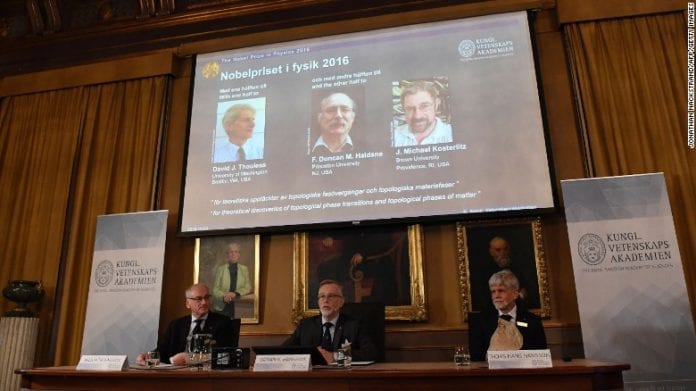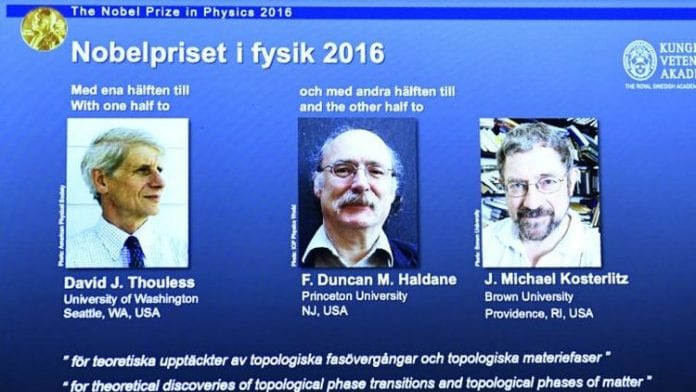This year’s physics Noble Prize has been given to 3 outstanding researchers who through their work changed the way we see matter transform. The three are – from University of Washington: David Thouless, from Princeton University: Duncan Haldane, from Brown University: Michael Kosterlitz. According to the Nobel committee, the three won the prestigious prize for the discoveries they made in topological phase changes as well as matter topological phases.
Explaining this year’s Nobel Prize in simple terms, John Chalker, he said that there are two reasons people win the prize, namely – experimental and discovery made concerning Higgs boson, and the other is for new ideas that play important role in the way we reason. The last point is the reason this year’s prize.
With physics, we come to make sense of many things no matter how small, sub-atomic to very big issues like holes in cosmology. But for the 2016 Nobel Prize for the area of Physics, the prize is as a result of physics in condensed-matter that has to do with materials we see everyday like semiconductors that are in our computer chips.

When they embarked on the research in the 1970s, the 3 winners were probably not thinking that their work will give birth to some applications. Their major aim was to tackle scientific puzzle making use of ideas in maths in the area referred to as topology that deals with the study of objects of geometrical properties.
One of such research was to find out the unusual behaviour that superconductors has especially when under temperatures that are at their lowest which do not in any way resist the electrical current that passes through them. In the normal circumstance, such superconductor is supposed to lose its potential as it goes through normal temperature. All parts of the wire will undergo the same process with no part of the wire not experiencing superconductivity.
The wire is expected to behave differently if it is made from a thin sheet. In this situation, all the wire is not expected to have the same transformation as some will lose superconductivity.
It was Kosterlitz and Thouless that made sense why this happens. In the 1940s, many researchers tried a great deal to understand semiconductors. These metals in question only conduct a small amount of electricity which, yes, were materials but had little value. It was after scientists found out that they behaved differently that they embarked on developing applications specifically for them. We can see one of such known as the integrated circuit which we can find in smartphones and computers all over the world.
Another puzzle was that of the effect of quantum Hall. When it was first discovered, it won the Nobel Prize in 1985 but was not delved into further after that.
Announcement of the 2016 #NobelPrize in Chemistry https://t.co/178yYTWqxQ
— The Nobel Prize (@NobelPrize) October 5, 2016
Here is how the effect of classical Hall that was discovered in the 1870s happen – get a sheet of metal and then on the opposite edges like the on the bottom and top, apply the voltage to the sides. What you will get is electrical current passing through the sheet, but when you the perpendicular magnetic field to the sheet, electrons will move from the bottom and top to the right and left edges. The result is a drop in voltage at the two-edged, and this is what is referred to as Hall voltage.
Thouless found that topological invariants concept can be used to explain the effect quantum Hall has on a thin sheet. In the 1980s, Haldane applied the principle to state that with or without the magnetic field, the effect of quantum Hall will still be present and this was confirmed in 2013.
It was the work of these 3 scientists that gave birth to topological insulators that will one day offer some use to applications we are yet to conceive.









